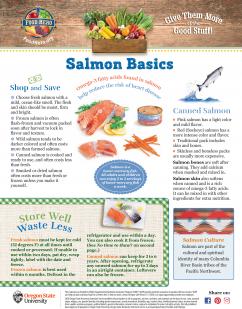Salmon Basics
Omega-3 fatty acids found in salmon help reduce the risk of heart disease
Shop and Save
- Choose fresh salmon with a mild, ocean-like smell. The flesh and skin should be moist, firm and bright.
- Frozen salmon is often flash-frozen and vacuum packed soon after harvest to lock in flavor and texture.
- Wild salmon tends to be darker colored and often costs more than farmed salmon.
- Canned salmon is cooked and ready to use, and often costs less than fresh.
- Smoked or dried salmon often costs more than fresh or frozen unless you make it yourself.
Store Well Waste Less
Fresh salmon
must be kept ice cold (32 degrees F) at all times until cooked or processed. If unable to use within two days, pat dry, wrap tightly, label with the date and freeze.
Frozen salmon
is best used within 6 months. Defrost in therefrigerator and use within a day. You can also cook it from frozen. (See No time to thaw? on second page.)
Canned salmon
can keep for 3 to 6 years. After opening, refrigerate any unused salmon for up to 3 days in an airtight container. Leftovers can also be frozen.
Canned Salmon
- Pink salmon has a light color and mild flavor.
- Red (Sockeye) salmon has a more intense color and flavor.
- Traditional pack includes skin and bones.
- Skinless and boneless packs are usually more expensive. Salmon bones are soft after canning. They add calcium when mashed and mixed in. Salmon skin also softens when canned and is a rich source of omega-3 fatty acids. It can be mixed in with other ingredients for extra nutrition.
Salmon Culture
Salmon are part of the cultural and spiritual identity of many Columbia River Basin tribes of the Pacific Northwest.
Enjoying Salmon
Recipes
Salmon Patties
Oven Baked Salmon
No time to thaw?
Bake salmon from frozen:
Preheat the oven to 450 degrees F. Place the frozen salmon pieces in a foil-lined baking dish. Tightly cover the dish (without the cover touching the salmon) and bake for 15 minutes. Remove the cover, drizzle the salmon with oil, season with salt and pepper and cook uncovered for 10 to 12 minutes until it is opaque on the outside and flakes when tested with a fork.
Kids Can!
When kids help make healthy food, they are more likely to try it. Show kids how to:
- tear bread
- beat eggs
- measure ingredients
- mash soft bones with a fork




